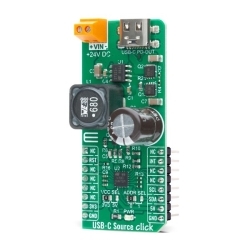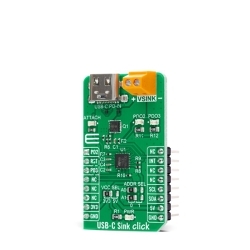MIKROE USB-C Source Click
USB-C Source Click is a compact add-on board that contains a standalone autonomous USB power delivery controller.
Product Overview
USB-C Source Click is a compact add-on board that contains a standalone autonomous USB power delivery controller. This board features the STUSB4700, an independent USB power delivery controller optimized as a provider to negotiate a given amount of power to be sourced to an inquiring consumer device from STMicroelectronics. The main functions of the STUSB4700 are discovery, configuration, and monitoring of the VBUS: Type-C low, medium, or high current mode. Additionally, it offers 5 customizable power data objects (PDOs), several GPIOs, an integrated discharge path, and is natively robust to high voltage peaks. This Click board™ is suitable for any type-C source device, AC adapters, and power supplies for computer, consumer or portable consumer applications, and more.
USB-C Source Click is based on the STUSB4700, a standalone autonomous USB power delivery controller optimized as a provider to negotiate a given amount of power to be sourced to an inquiring consumer device from STMicroelectronics. Combining high-voltage capability with low power consumption, the STUSB4700 can be safely used in systems that handle high voltage on the VBUS power path. The device integrates an internal circuitry on the CC pins that tolerate high voltage and ensures protection up to 22 V in case of unexpected short circuit with VBUS or in case of connection to a device supplying high voltage on VBUS.
This Click board™ is powered from an external power supply voltage terminal to which a fixed voltage value of 24V is applied. After that, an input supply voltage goes through the ST1S14, a step-down monolithic power switching regulator able to deliver up to 3A DC current to the load depending on the application conditions also from STMicroelectronics. This Buck regulator establishes communication with another Sink device via a USB connector that represents a Power Delivery Output Connector.
In the source power role, the STUSB4700’s VBUS_EN_SRC pin allows the enabling of the outgoing VBUS power when the connection to a sink is established and VBUS is in the valid operating range. The open-drain output allows a PMOS transistor to be driven directly. It also has the VBUS_SENSE pin used to sense VBUS presence, monitor VBUS voltage, and discharge VBUS on the USB Type-C receptacle side.
The STUSB4700 communicates with MCU using the standard I2C 2-wire interface that supports transfers up to 400 Kbit/s (Fast Mode) used to configure, control, and read the status of the device. It also has the possibility of the USB Power Delivery communication over CC1 and CC2 configuration channel pins used for connection and attachment detection, plug orientation determination, and system configuration management across USB Type-C cable. Two addresses are available by default (0x28 and 0x29) depending on the setting of the address pin ADDR0 of the STUSB4700 programmed by the user, which determines the LSB of the peripheral address, and it can be selected by onboard SMD jumper labeled as ADDR SEL allowing selection of the peripheral address LSB.
Additional functionality, such as Reset and ‘Alert’ interrupt is provided and routed at RST and INT pins of the mikroBUS™ socket. The RST pin resets all analog signals, states machine, and reloads configuration, while an interrupt output labeled as INT represents alarm output.
This Click board™ is designed to be operated with both 3.3V and 5V logic voltage levels that can be selected via VCC SEL jumper. This allows for both 3.3V and 5V capable MCUs to use the I2C communication lines properly. However, the Click board™ comes equipped with a library that contains easy to use functions and an example code that can be used as a reference for further development.
Features & Specs
- Interface: I2C
- Compatibility: mikroBUS™
- Dimensions: 57.15 x 25.4mm
- Input Voltage: 3.3V or 5V
- Supply Voltage: 24V
- Supply Voltage on CC pins: Min. -0.3V, Max. 3.5V
- Operating Supply Current: 188μA
- Operating Temperature Range: -40°C to +105°C
Documentation
Customer Reviews

Stock and Customer Discounts
Available Discounts
- $30.35 | 25+ units
- $28.76 | 100+ units








